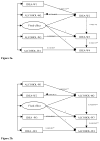Suicidal ideation and substance use among adolescents and young adults: a bidirectional relation?
- PMID: 24969957
- PMCID: PMC4129651
- DOI: 10.1016/j.drugalcdep.2014.05.025
Suicidal ideation and substance use among adolescents and young adults: a bidirectional relation?
Abstract
Objective: To examine reciprocal associations between substance use (cigarette smoking, use of alcohol, marijuana, and other illegal drugs) and suicidal ideation among adolescents and young adults (aged 11-21 at wave 1; aged 24-32 at wave 4).
Methods: Four waves public-use Add Health data were used in the analysis (N=3342). Respondents were surveyed in 1995, 1996, 2001-2002, and 2008-2009. Current regular smoking, past-year alcohol use, past-year marijuana use, and ever use of other illegal drugs as well as past-year suicidal ideation were measured at the four waves (1995, 1996, 2001-2002, and 2008-2009). Fixed effects models with lagged dependent variables were modeled to test unidirectional associations between substance use and suicidal ideation, and nonrecursive models with feedback loops combining correlated fixed factors were conducted to examine reciprocal relations between each substance use and suicidal ideation, respectively.
Results: After adjusting for the latent time-invariant effects and lagged effects of dependent variables, the unidirectional associations from substance use to suicidal ideation were consistently significant, and vice versa. Nonrecursive model results showed that use of cigarette or alcohol increased risk of suicidal ideation, while suicidal ideation was not associated with cigarette or alcohol use. Reversely, drug use (marijuana and other drugs) did not increase risk of suicidal ideation, but suicidal ideation increased risk of illicit drug use.
Conclusion: The results suggest that relations between substance use and suicidal ideation are unidirectional, with cigarette or alcohol use increasing risk of suicidal ideation and suicidal ideation increasing risk of illicit drug use.
Keywords: Adolescents; Alcohol use; Drug use; Regular smoking; Suicidal ideation; Young adults.
Copyright © 2014 Elsevier Ireland Ltd. All rights reserved.
Conflict of interest statement
Figures








Similar articles
-
Reciprocal relationships between substance use and disorders and suicidal ideation and suicide attempts in the Collaborative Study of the Genetics of Alcoholism.J Affect Disord. 2017 Apr 15;213:96-104. doi: 10.1016/j.jad.2016.12.060. Epub 2017 Feb 3. J Affect Disord. 2017. PMID: 28213124 Free PMC article.
-
Relationship between marijuana and other illicit drug use and depression/suicidal thoughts among late middle-aged and older adults.Int Psychogeriatr. 2016 Apr;28(4):577-89. doi: 10.1017/S1041610215001738. Epub 2015 Nov 6. Int Psychogeriatr. 2016. PMID: 26542746
-
Longitudinal associations of cannabis and illicit drug use with depression, suicidal ideation and suicidal attempts among Nova Scotia high school students.Drug Alcohol Depend. 2013 Apr 1;129(1-2):49-53. doi: 10.1016/j.drugalcdep.2012.09.009. Epub 2012 Oct 5. Drug Alcohol Depend. 2013. PMID: 23041136
-
Suicide ideation and psychotropic recreational drug use by adolescents: a systematic review and meta-analysis.Sao Paulo Med J. 2024 Apr 22;142(4):e2022641. doi: 10.1590/1516-3180.2022.0641.R2.23012024. eCollection 2024. Sao Paulo Med J. 2024. PMID: 38655989 Free PMC article.
-
A meta-analysis of the relationship between trait mindfulness and substance use behaviors.Drug Alcohol Depend. 2014 Oct 1;143:1-10. doi: 10.1016/j.drugalcdep.2014.07.014. Epub 2014 Jul 24. Drug Alcohol Depend. 2014. PMID: 25113434 Free PMC article. Review.
Cited by
-
Sexual Orientation-Related Disparities in High-Intensity Binge Drinking: Findings from a Nationally Representative Sample.LGBT Health. 2019 Jul;6(5):242-249. doi: 10.1089/lgbt.2018.0244. Epub 2019 Jun 10. LGBT Health. 2019. PMID: 31184966 Free PMC article.
-
From cross-lagged effects to feedback effects: Further insights into the estimation and interpretation of bidirectional relations.Behav Res Methods. 2024 Apr;56(4):3685-3705. doi: 10.3758/s13428-023-02304-0. Epub 2023 Dec 21. Behav Res Methods. 2024. PMID: 38129735
-
Suicide victims and alcohol-related consumption in Brazil: An observational study and a narrative review of the literature.Forensic Sci Med Pathol. 2024 Dec;20(4):1310-1317. doi: 10.1007/s12024-023-00766-4. Epub 2023 Dec 27. Forensic Sci Med Pathol. 2024. PMID: 38151659 Free PMC article. Review.
-
Illicit Drug Use in Canada and Implications for Suicidal Behaviors, and Household Food Insecurity: Findings from a Large, Nationally Representative Survey.Int J Environ Res Public Health. 2021 Jun 14;18(12):6425. doi: 10.3390/ijerph18126425. Int J Environ Res Public Health. 2021. PMID: 34198517 Free PMC article.
-
Use of Alcohol, Tobacco, and Caffeine and Suicide Attempts: Findings From a Nationally Representative Cross-sectional Study.J Prim Care Community Health. 2020 Jan-Dec;11:2150132720913720. doi: 10.1177/2150132720913720. J Prim Care Community Health. 2020. PMID: 32193974 Free PMC article.
References
-
- Allison PD. Using panel data to estimate the effects of events. Sociol Method Res. 1994;23:179–199.
-
- Bentler PM. Comparative fit indexes in structural models. Psychol Bull. 1990;107:238–246. - PubMed
-
- Boden JM, Fergusson DM, Horwood LJ. Cigarette smoking and suicidal behavior: results from a 25-year longitudinal study. Psychol Med. 2008;38:433–439. - PubMed
Publication types
MeSH terms
Substances
Grants and funding
LinkOut - more resources
Full Text Sources
Other Literature Sources
Medical
Miscellaneous

